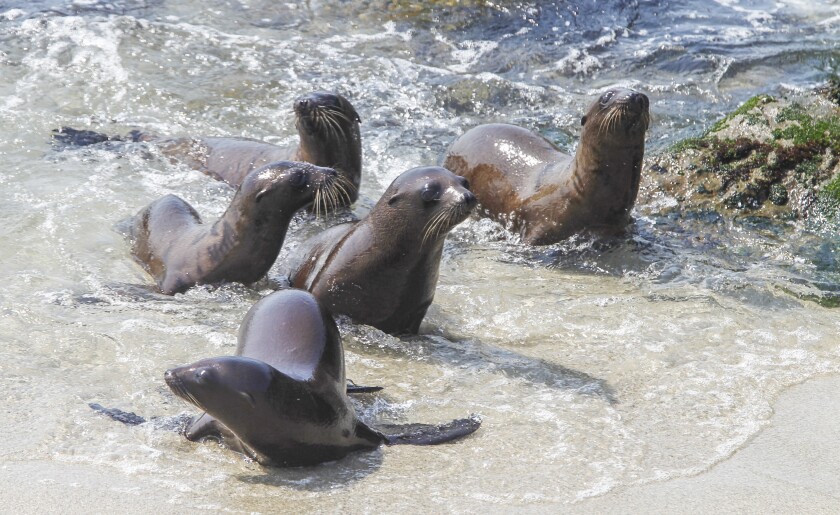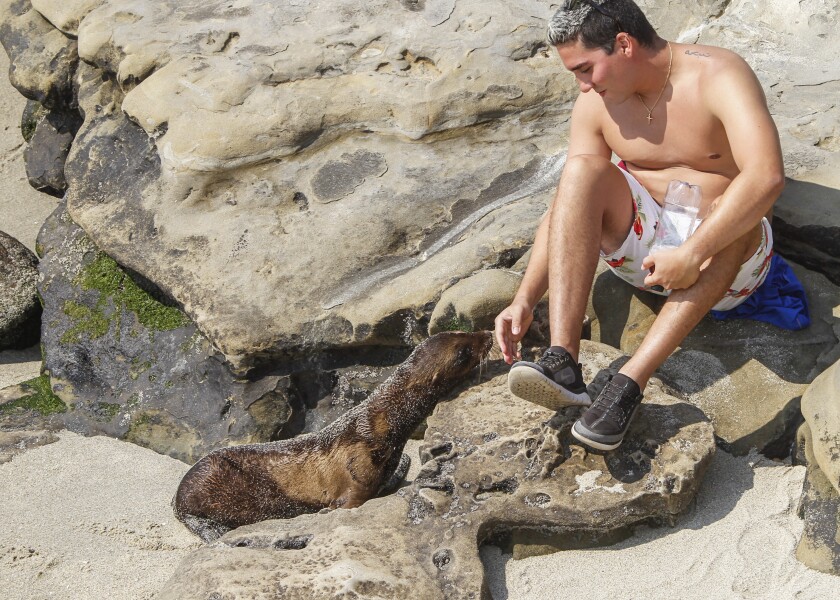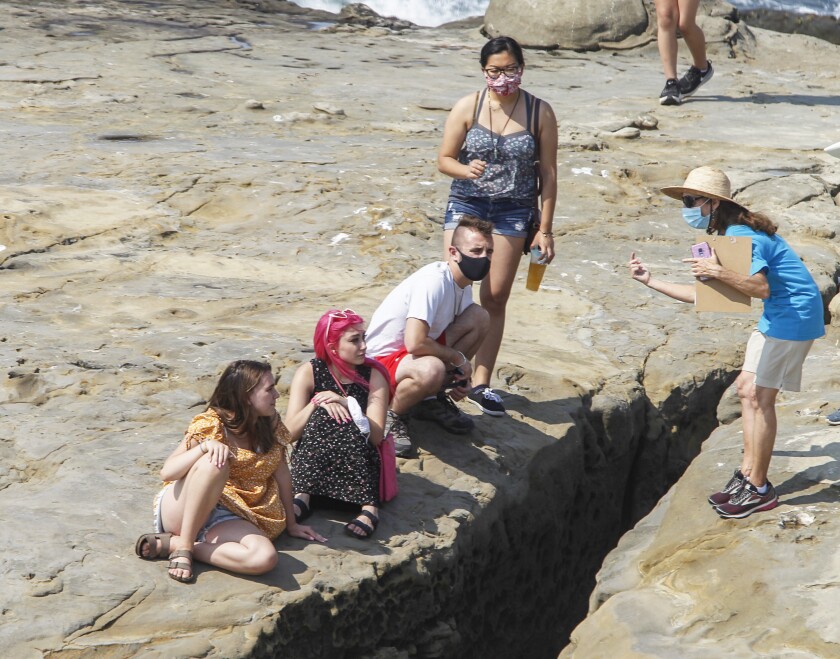A pair of sea lion pups splashed and played at Point La Jolla last week, chasing each other in circles through a sheltered pool, while other pups lounged on the beach or sheltered in a crevice between rocks.
Surrounding them was a crowd of visitors, cellphones in hand, some within arms reach of the baby marine mammals.
The spur of land between La Jolla Cove and Boomer’s Beach is one of a handful of sea lion rookeries, or birthing beaches, on mainland California, making it a rare place to view the newborn pups with their mothers. But throngs of visitors, captivated by the baby sea lions, may be placing both themselves and the animals at risk, wildlife advocates say.
Spectators who approach the animals can cause them to retreat into the sea, disrupting their normal behavior and possibly separating mothers and pups, said Robyn Davidoff, a docent with the Sierra Club Seal Society of San Diego, a volunteer group dedicated to preserving the region’s harbor seals and sea lions.
Touching the young sea lions can interfere with the scent recognition that is key to mother-baby bonding, and even cause mothers to abandon their young. The animals may also charge people, or bite defensively if they feel threatened or harassed.
“People see someone taking selfies, and they think it’s okay to get that close,” Davidoff said. “Then they get chased by a sea lion, or nipped at.”

SAN DIEGO, CA - AUGUST 19: Sea lion pups at a rookery at Boomer Beach next to Point La Jolla on Wednesday, Aug. 19, 2020 in San Diego, CA. (Eduardo Contreras / The San Diego Union-Tribune)
(Eduardo Contreras / The San Diego Union-Tribune)
The Seal Society is asking the city to discourage that kind of close contact through public information about sea lion behavior and safe viewing guidelines. They’ve presented to the San Diego City Environment Committee, and met with Councilwoman Jen Campbell, who chairs the body. They are also communicating with Councilwoman Barbara Bry, who represents the district. Campbell’s office could not be reached for comment for this story. Bry declined to comment, but one of her community representatives, Moriah Gaynor, said the councilwoman plans to tour the site over the weekend.
“We’re working with park and recreation rangers to get improved signage, to raise awareness for people about sea lions,” Davidoff said. “We talk to people at the beach, educate them about sea lion breeding, and ask them to give some space and step back. We really try to take an educational approach.”
City of San Diego park rangers have worked to increase public awareness of the increasing number of sea lions in La Jolla, said Timothy Graham, a public information officer for the City of San Diego. The city has placed educational signage at the site, sprayed it with enzyme treatment to reduce odor, and placed a gate at the bottom of the beach access stairs to prevent sea lions from climbing up to the urban area, he said. It also opened an intepretive table staffed by interns, but that was curtailed at the beginning of the pandemic, and the Parks and Recreation Department is developing plans to reopen it.
Davidoff said, however that those steps aren’t enough, and some of the measures haven’t been implemented effectively. She said that she and other volunteers rarely see rangers at the site, and the rangers haven’t shown up to intervene when docents have called them about problems. The interpretive tent, even when open, is too far from the site, and the interns working there lack the training and experience to manage public behavior toward the animals, she said.
The Seal Society is asking the city to post rangers at the site daily, or at minimum all day on weekends, to enforce safe viewing guidelines. They also want the city to set safe viewing distances that visitors should maintain from the animals; they’re recommending at least 50 feet, the limit set for nearby Children’s Pool, where people interact with sea lions and harbor seals on the beach. They would like those guidelines posted prominantly along the wall above La Jolla Point and Boomer’s Beach, and on the rocks below. And they’re asking the city to close the beach access stairs to the site during pupping season, between June 1 and October 1.
Officials with the National Oceanic and Atmospheric Administration plan to post additional signs at the site, and conduct a public education campaign to help visitors safely view the animals, spokesman Michael Milstein said.
On the afternoon last week, dozens of visitors shared the beach with the sea lions, including groups of pups that waited for their mothers to return from fishing expeditions. Davidoff approached some of the viewers, asking if they had questions, and explaining their pupping process and behavior.
“Why are they on the land,” asked Amber King, visiting the site with her husband Connor, from Huntington Beach.
Baby sea lions nurse for six months, so the mothers must eat enough to feed both of them, but in the meantime their pups remain unguarded on the beach, Davidoff said.
“This is the playpen,” King noted. “That’s amazing. This is better than Sea World.”
When the mothers return, they bark for their pups, and the youngsters return the call, until they meet and greet each other by scent. That’s why it’s so important to refrain from touching them, Davidoff said. Spotting one man sitting on a rock next to a group of pups covered in sand, she asked him to keep his distance from the animals.

SAN DIEGO, CA - AUGUST 19: Beach goer, Diego Angulo (right) moves in close to view a sea lion pup at a rookery at Boomer Beach next to Point La Jolla on Wednesday, Aug. 19, 2020 in San Diego, CA. (Eduardo Contreras / The San Diego Union-Tribune)
(Eduardo Contreras / The San Diego Union-Tribune)
“If you touch it, the mom might not feed it anymore,” she said.
“Thank you lady,” the man, Diego Angulo said, backing away from the animal.
Most of the beachgoers were interested in the information, and receptive to the request to stay clear of them, though few backed up as far as the 50 foot guideline that the Seal Society hopes to see enforced.
This kind of close interaction between the public and pupping sea lions is fairly recent and very rare, said Sharon Melin, wildlife research biologist with the National Oceanic and Atmospheric Administration, and lead of the California Current sea lion program. Historically, sea lions didn’t have their young on the mainland, but instead gave birth on islands where they were safe from land predators.
More recently, some small rookeries began to appear on the California mainland, she said, but most of those are small pockets of animals at inaccessible beaches off the Central Coast.
“Those are very isolated places where the public cannot get to them,” she said. “There are huge cliffs, and they are very safe, tucked in there. At (La Jolla) a situation like that where they’re pupping in a very public place, where people are interacting them them on a regular basis, we don’t see any other places like that.”

SAN DIEGO, CA - AUGUST 19: Robyn Davidoff (right), a docent with The Seal Society of San Diego, talks with beach goers about the sea lions and their pups at a rookery at Boomer Beach next to Point La Jolla on Wednesday, Aug. 19, 2020 in San Diego, CA. (Eduardo Contreras / The San Diego Union-Tribune)
(Eduardo Contreras / The San Diego Union-Tribune)
Sea lion populations have been up and down over the past few decades. For much of the last century, their numbers declined as the animals were trapped accidentally in fishnets, shot by fishermen, and suffered low birth rates because of DDT in their blubber. Their population was just shy of 89,000 in 1975, three years after the Marine Mammal Protection Act took effect, but by 2012, their numbers rose to more than 300,000.
A year later, however, young, starving sea lions began arriving on beaches throughout California, in mass stranding events. Scientists later determined that those were due to changes in the prey base that left the mothers malnourished and unable to feed their pups. The population is now estimated to be about 230,000 to 250,000, Melin said.
The animals are adaptable, and adjust to the presence of people, so the colony at La Jolla should be fairly stable, as long as people give them their space, she said.
That protects people as well as the pups, she said. Sea lions are curious about people, but can occasionally be aggressive. Some divers or snorkelers have been bitten while swimming with sea lions, she said, so the distance protects both people and animals.
“It’s a fabulous opportunity for people to see them doing what they do naturally,” Melin said. “Most of the pupping goes on in places that are really remote. So that fact that this goes on there is really novel. But you really want to respect their natural behavior.”
At Point La Jolla last week, a large bull patrolled the beach, barking out his claim on the territory. Female sea lions played in the surf, watching over their young. One mother waddled onto the beach, trailed by her pup, and then lay down on the sand as her baby snuggled alongside her in the sun.
The Link LonkAugust 24, 2020 at 02:02AM
https://ift.tt/2YtPqX3
Selfies with sea lions and their pups? Not a good idea, officials say - The San Diego Union-Tribune
https://ift.tt/2CoSmg4
Sea
/cloudfront-us-east-2.images.arcpublishing.com/reuters/CZF6NULMVVMEXHOP7JK5BSPQUM.jpg)
No comments:
Post a Comment